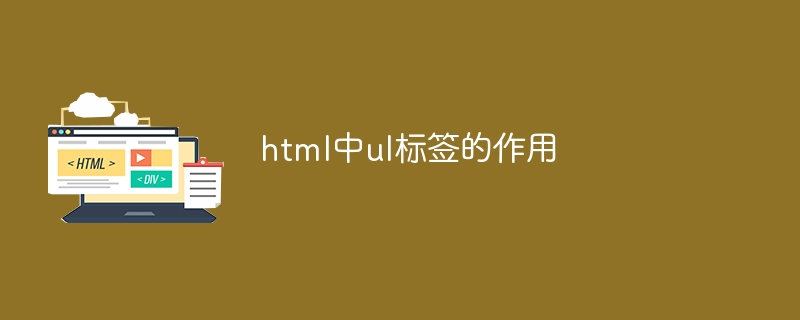The role of ul tag in html
The ul tag in HTML is used to create a list of items in no particular order or priority. To use ul tags, wrap the list items inside a li tag and use the ul tag as the container. The ul tag supports type, compact, and start attributes to customize the appearance and behavior of the list. The advantages of using ul tags to create lists include readability, unordering, and scalability. Other alternative list elements include ol (ordered list), dl (definition list), and menu (menu list).

The role of the ul tag in HTML
The ul tag represents an unordered list in HTML and is used to create a list of items, each of which The items are in no particular order or priority.
How to use the ul tag
To create an unordered list, use the ul tag as the container and encapsulate the list items in the li tag. The syntax is as follows:
<ul> <li>列表项 1</li> <li>列表项 2</li> <li>列表项 3</li> </ul>
ul Attributes of the tag
The ul tag supports several attributes that can be used to customize the appearance and behavior of the list:
- type :Specifies the mark type of the item, which can be disc (dot), circle (circle) or square (square).
- compact: Create a compact list with no spacing between items.
- start: Specifies the number of the first item in the list.
Advantages of ul tags
There are several advantages of using ul tags to create lists:
- Readability:Unordered Lists make information easier to read and scan.
- Unordered: Allows items to be listed in any order without specifying a priority.
- Extensibility: Items can be easily added or removed without affecting other items.
Alternatives
In some cases, other HTML elements can replace the ul tag to create the list:
- ol tag: Use an ordered list where items are numbered in a specific order.
- dl tag: Use a definition list where items contain terms and definitions.
- menu tag: Use a menu list, usually used for website navigation.
The above is the detailed content of The role of ul tag in html. For more information, please follow other related articles on the PHP Chinese website!

Hot AI Tools

Undresser.AI Undress
AI-powered app for creating realistic nude photos

AI Clothes Remover
Online AI tool for removing clothes from photos.

Undress AI Tool
Undress images for free

Clothoff.io
AI clothes remover

AI Hentai Generator
Generate AI Hentai for free.

Hot Article

Hot Tools

Notepad++7.3.1
Easy-to-use and free code editor

SublimeText3 Chinese version
Chinese version, very easy to use

Zend Studio 13.0.1
Powerful PHP integrated development environment

Dreamweaver CS6
Visual web development tools

SublimeText3 Mac version
God-level code editing software (SublimeText3)

Hot Topics
 1378
1378
 52
52
 What is the purpose of the <progress> element?
Mar 21, 2025 pm 12:34 PM
What is the purpose of the <progress> element?
Mar 21, 2025 pm 12:34 PM
The article discusses the HTML <progress> element, its purpose, styling, and differences from the <meter> element. The main focus is on using <progress> for task completion and <meter> for stati
 What is the purpose of the <datalist> element?
Mar 21, 2025 pm 12:33 PM
What is the purpose of the <datalist> element?
Mar 21, 2025 pm 12:33 PM
The article discusses the HTML <datalist> element, which enhances forms by providing autocomplete suggestions, improving user experience and reducing errors.Character count: 159
 What are the best practices for cross-browser compatibility in HTML5?
Mar 17, 2025 pm 12:20 PM
What are the best practices for cross-browser compatibility in HTML5?
Mar 17, 2025 pm 12:20 PM
Article discusses best practices for ensuring HTML5 cross-browser compatibility, focusing on feature detection, progressive enhancement, and testing methods.
 What is the purpose of the <meter> element?
Mar 21, 2025 pm 12:35 PM
What is the purpose of the <meter> element?
Mar 21, 2025 pm 12:35 PM
The article discusses the HTML <meter> element, used for displaying scalar or fractional values within a range, and its common applications in web development. It differentiates <meter> from <progress> and ex
 How do I use HTML5 form validation attributes to validate user input?
Mar 17, 2025 pm 12:27 PM
How do I use HTML5 form validation attributes to validate user input?
Mar 17, 2025 pm 12:27 PM
The article discusses using HTML5 form validation attributes like required, pattern, min, max, and length limits to validate user input directly in the browser.
 What is the viewport meta tag? Why is it important for responsive design?
Mar 20, 2025 pm 05:56 PM
What is the viewport meta tag? Why is it important for responsive design?
Mar 20, 2025 pm 05:56 PM
The article discusses the viewport meta tag, essential for responsive web design on mobile devices. It explains how proper use ensures optimal content scaling and user interaction, while misuse can lead to design and accessibility issues.
 What is the purpose of the <iframe> tag? What are the security considerations when using it?
Mar 20, 2025 pm 06:05 PM
What is the purpose of the <iframe> tag? What are the security considerations when using it?
Mar 20, 2025 pm 06:05 PM
The article discusses the <iframe> tag's purpose in embedding external content into webpages, its common uses, security risks, and alternatives like object tags and APIs.
 Gitee Pages static website deployment failed: How to troubleshoot and resolve single file 404 errors?
Apr 04, 2025 pm 11:54 PM
Gitee Pages static website deployment failed: How to troubleshoot and resolve single file 404 errors?
Apr 04, 2025 pm 11:54 PM
GiteePages static website deployment failed: 404 error troubleshooting and resolution when using Gitee...




